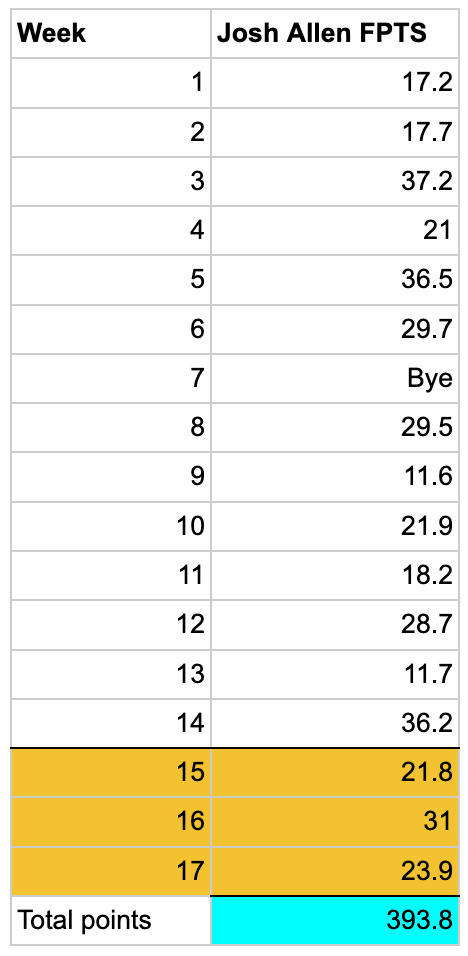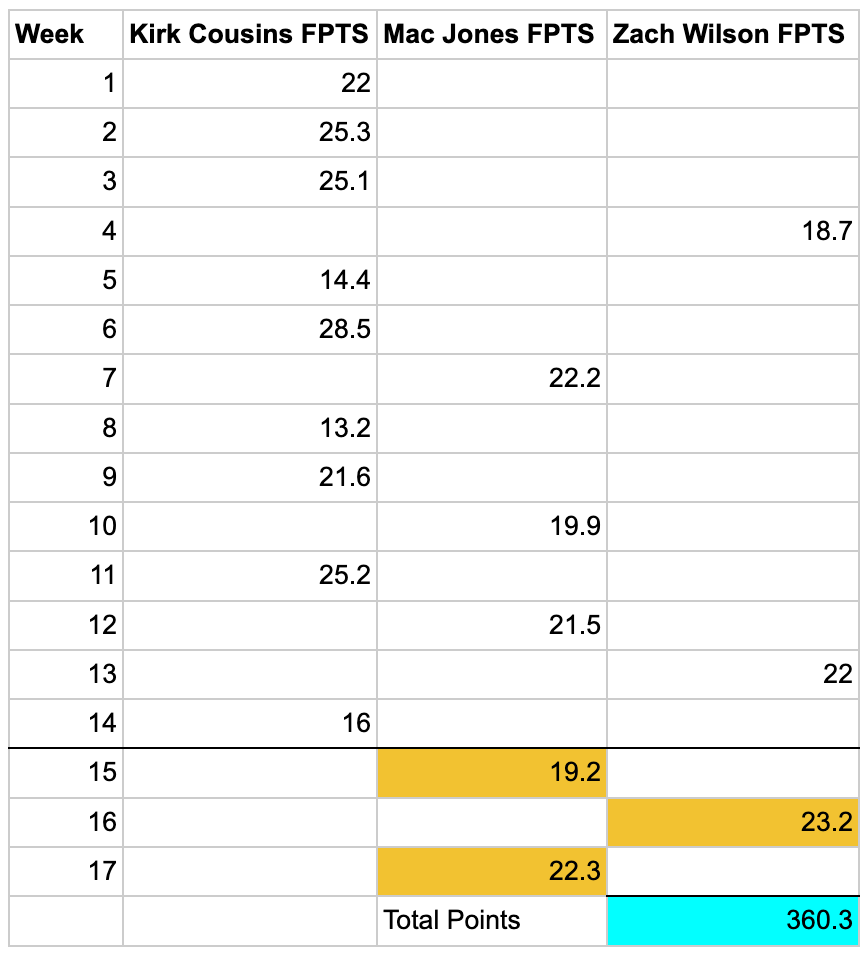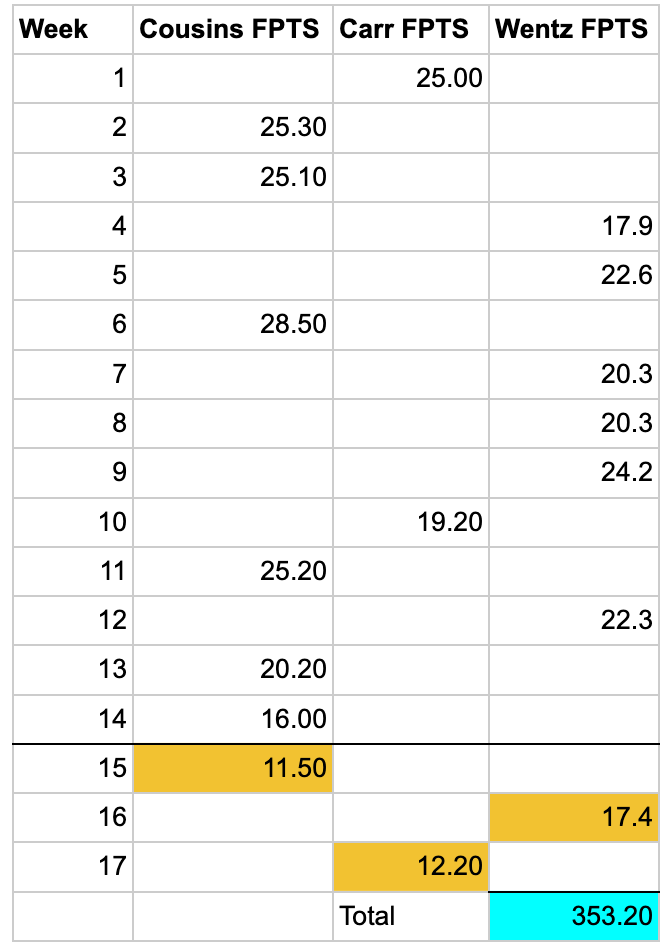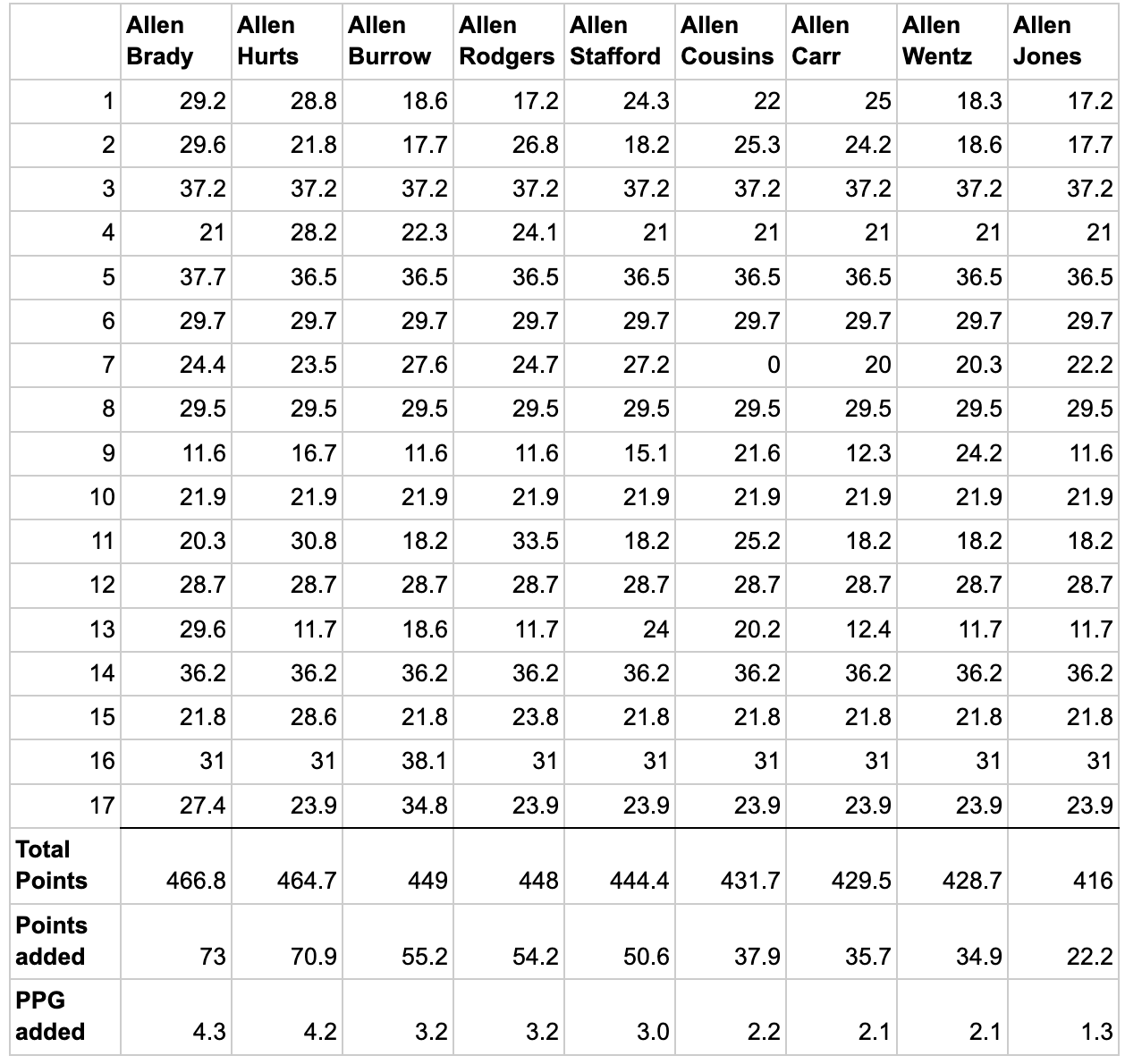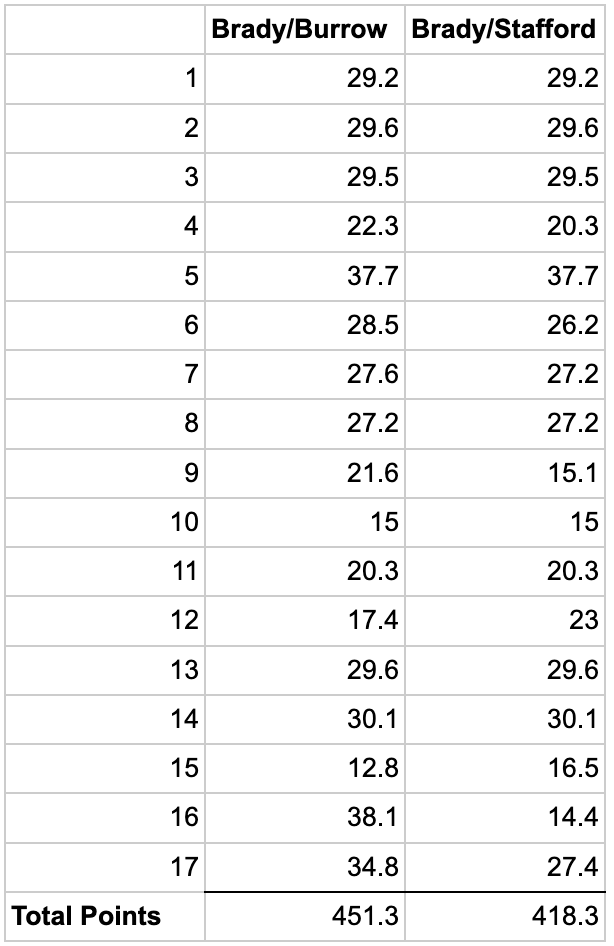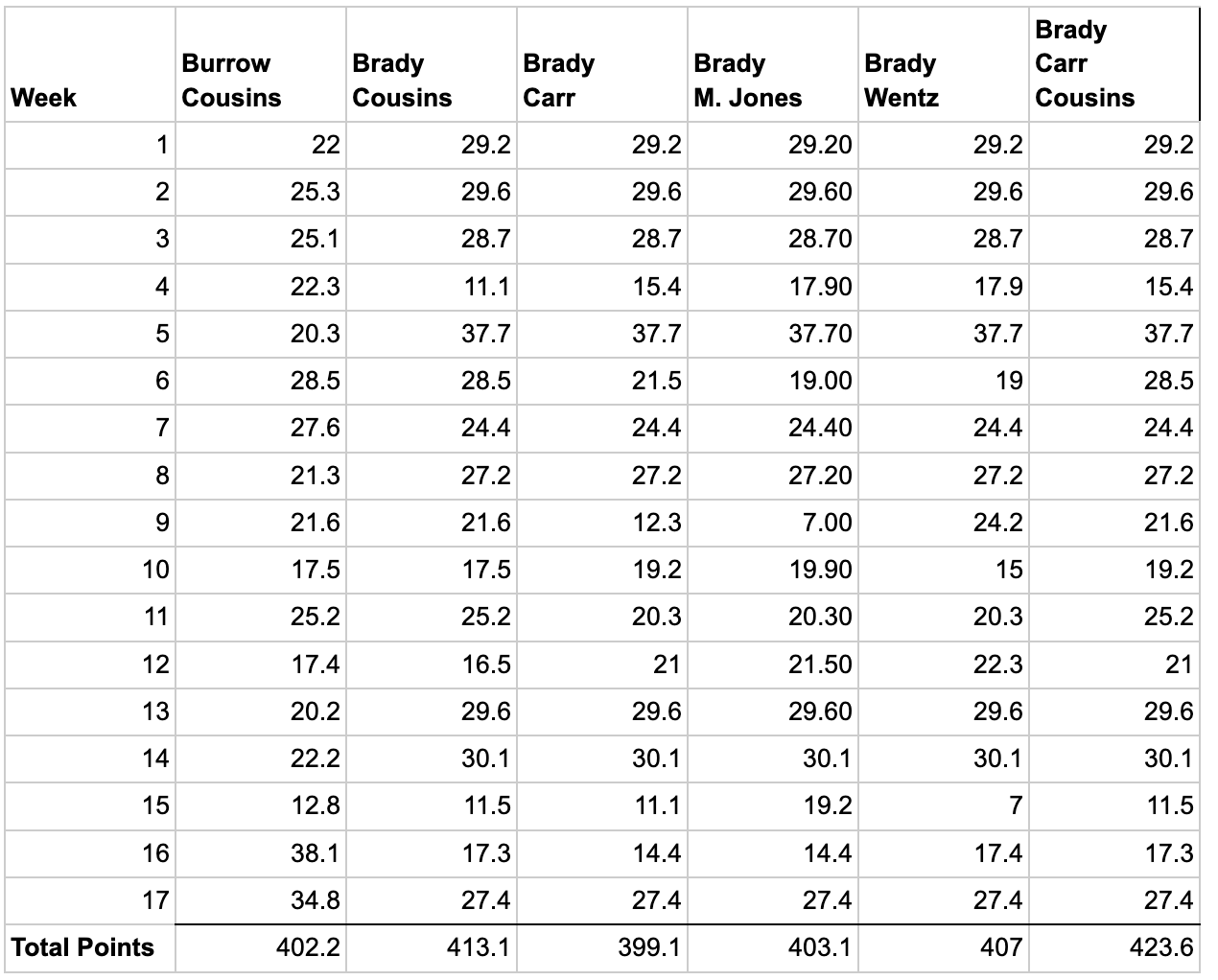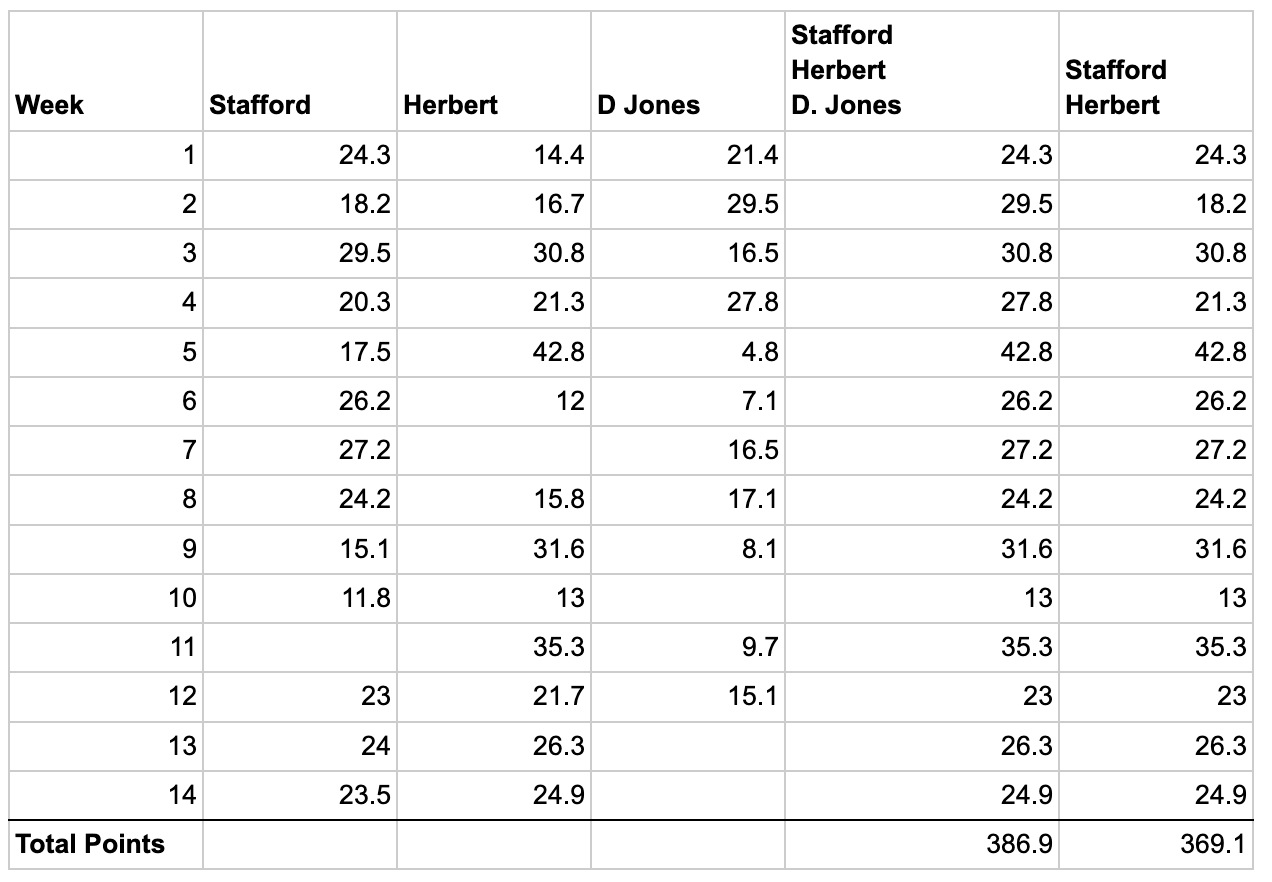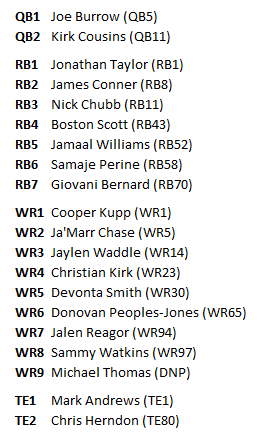Hello everyone, I’m Liam Murphy – last year’s Best Ball Mania II winner at Underdog Fantasy ($1 million to 1st place) – and this is my first ever fantasy football article. I play high volume and high stakes of season long fantasy, best ball fantasy, and DFS.
Today’s article will be filtered through the lens of QB strategies and how that affects roster builds in large-field best ball tournaments. What were the strategies employed by the top best ball teams throughout the full fantasy season (Weeks 1-17)? How often did teams employing this strategy advance through the tournament rounds (Weeks 15-17) and into the finals (Week 17)? How viable was drafting a handful of “late-round QBs” in comparison to teams who “merely” drafted the overall fantasy QB1 Josh Allen? And what are the advantages and disadvantages of each strategy when it comes to other positions?
Over the last two seasons, the fantasy market has been really good at identifying which QBs will score a high number of fantasy points and which ones will not. FantasyPoints’ own Jeff Henderson has argued that (at least in start/sit leagues) an early-round QB strategy was close to optimal last season, or at least just as competitive as an early-round RB or Zero-RB approach, and that Josh Allen may now actually be worth a Round 1 pick. Using this logic it’s pretty tempting to want to gravitate towards the safety – and maybe even value – a premium QB provides.
I’m sympathetic to that line of thinking, but in best ball tournaments we always want to gravitate towards upside. And, obviously, if we can get strong QB production with a later pick our roster will have a higher ceiling. I also think that while the elite QBs seem to be separating themselves from the pack, the caliber of athlete entering the NFL each year is growing increasingly stronger, and coaches are doing more to build around their skill sets. This means that eventually very few teams will be starting bad QBs or non-rushing QBs — which will again make a Late-Round QB-approach a more viable draft strategy. Which is to say, when one of the supposed “worst” QBs in the NFL is an old Matt Ryan, then the league is in really great hands. Or, rather, the days of Trent Edwards or Nathan Peterman being starters is hopefully over.
Before we begin, I’d like to add the caveat that, in best ball leagues, we should always be careful making sweeping generalizations from historical data. The NFL season is very chaotic, our sample size is very low, the fantasy football draft landscape changes each year, and for large-field contests with playoff weeks — like BBM2 — what ultimately “worked” comes down to who scored points in weeks 15-17 (an even smaller sample size). I still think it’s useful — and good — process to review what worked in the past, and as we add years of data hopefully we’ll be able to identify patterns to make us the most money.
If you’re going to be joining a best ball league, there is no better place to look than Underdog Fantasy. They have the slickest, cleanest, least-buggy, and the most user-friendly app in the space. Their rake is minimal (<11.5%). And the payouts can be massive (up to $2 million). And, lucky for you, if you sign up today using promo code FANTASYPTS, Underdog will match your deposit up to $100! Click here for more info.
Let’s start with the fantasy QB1 last year — Allen. In the table below you’ll see his weekly scores, his fantasy playoff scores (highlighted gold), and his weeks 1-17 score (highlighted light blue). For scoring purposes we’ll be using Underdog’s scoring system, which (for the QB position) is pretty uniform to the industry-standard, minus -2.0 points per fumble lost.
Allen scored 393.8 points from Weeks 1-17, buoyed by nearly seven weeks with 30-plus fantasy points. He also gave us an at least “usable” score each week in the fantasy playoffs.
Next I looked at all late round QBs (defined as Round 12 ADP or later on Underdog) who scored at least 20 points weeks 1-17. Again I repeated this process for weeks 15-17, the “money weeks” on Underdog and DraftKings for these large-field tournaments. I used 20 points as the arbitrary cutoff because I believed we needed ~20 or more points to hope to keep pace with elite QB production. For Underdog/DraftKings this process led us to the optimal three late round QBs to be on your team — Kirk Cousins (QB11), Mac Jones (QB17), and Zach Wilson (QB29).
By cherry-picking the optimal three late-round QBs for the playoff weeks, we arrive at 360.3 season long points. For the playoff weeks, we gave up 2.6 points Week 15, 7.8 points Week 16, and 1.6 points week 17 compared to Josh Allen alone. Allen — with a bye — outscored the three optimal late round QBs in both season long points and playoff points by himself.
But let’s look at a couple more things before we come to any conclusions.
I found it interesting that the top three late-round QBs from a season-long total points perspective — Kirk Cousins (QB11 - 285.44 points), Derek Carr (QB12 - 255.62), and Carson Wentz (QB15 - 252.92) — did not outscore our combination of Cousins, Jones, and Wilson.
A lot of this seems due to randomness, with Cousins/Carr/Wentz overlapping several of their spike weeks. But it also alludes to the idea that if you hit on a late-round QB you simply want to surround that QB with QBs who can spike rather than taking the “triple condom route” and drafting three “safe” QBs.
Next, let’s move on to review how many points you added to your roster by pairing different QBs with Josh Allen.
Should I take two QBs early?
I’d be remiss if I didn’t point out that the best QBs to draft last year, from a season-long total points-perspective, existed around the 10th round. This happened not only because these players were talented but also because we saw some injuries to the other elite QBs, like Lamar Jackson and Kyler Murray. The QBs we selected within that range were Tom Brady (QB3 - 361.7 points), Joe Burrow (QB5 - 328.24 points), Matthew Stafford (QB6 - 327.22 points), Aaron Rodgers (QB7 - 322.08 points), and Jalen Hurts (QB8 - 321.16 points). So what happens if you pair the QB1 Josh Allen with these QBs vs. some of our late-round hits (Cousins, Wentz, Carr, Mac Jones)? Let’s take a look at the chart below.
Under the total points row (meaning the total points the QB pair scored over Weeks 1-17) you’ll see the points added and PPG rows. Points added is the amount of points to your season score you added by pairing these QBs with Allen, and PPG is the total fantasy points added divided by 17 for points per game. Let’s see how these charts compare to two of our 10th-round hits.
Note that the QB1 (Allen) and QB3 (Brady) combo (466.8 points) barely outscored the QB3 (Brady) and QB5 (Burrow) combo (451.3 points).
QB Conclusions
With regard to last season, what was optimal depends on what format you were playing. What is good for scoring the most points is different from what is best for tournament formats. Of course you want to have an elite QB on your team, but — in order for your roster to score the most points — you want to avoid drafting QBs in the rounds where league winners most often emerge at other positions. (It’s especially rare for a QB to ever qualify as a “power-law player” or “league winner;” instead that designation is typically only reserved for RBs, WRs, and TEs. This was what Scott Barrett argued here, when looking back since 2017, and I will show this as well later in this article, focusing only on last year’s results.)
Using this logic, I’d say that for contests like Underdog and DraftKings it’s fine to invest in two elite QBs. The scores get wiped clean for the playoff weeks (where all the money is) and they act as individual DFS slates. It seems perfectly reasonable to me that the two elite QBs could “ping pong” off each other (alternate scoring a lot of points in Weeks 15-17) and allow you to sneak in a low-owned elite QB into the finals.
For a contest like Drafters, or if you’re targeting the million dollar prize on Underdog for most points scored weeks 1-14, it’s likely not optimal to invest two high draft picks in the QB position. Looking at last year, taking a QB in Rounds 4-6 meant you risked missing out on league winners such as Cooper Kupp, Mark Andrews, Ja’Marr Chase, and Deebo Samuel. Taking a QB in rounds 10-12 meant you risked missing out on league winners such as Leonard Fournette and James Conner. As you’ll see below, where I review what worked last year, if “league winners” exist in a draft round by ADP, you’ll almost certainly need them on your team to score the most points and thus win the contest.
In regard to what was actually optimal last year at QB you’ll have to decide for yourself how much the difference in the total points is worth the risk of missing out on power-law players at RB, WR, or TE. Intuitively, I’d say the Round 10 QBs were the best to take. I’d also say that pairing one of our Round 10 hits with only one of our late-round hits was best. Taking 3 QBs with a Round 10 hit added a negligible amount of points. I’ve shown several different QB pairings below to illustrate this.
Late-round QB targets this year
Looking at last year's data, if our goal is to score the most points, we’ll likely want to have one QB before the 11th round. So let’s look at the late round QBs I like this year and why.
I’d also like to point out that where QBs are drafted is different on each site. On Underdog, QBs typically go later, and on DraftKings earlier. So you’ll want to adjust your strategy on each site. Looking at Underdog ADP this year, the landscape is also different. Most of our 10th round hits from last year are now going around the 6th/7th (Hurts, Burrow, Brady). Stafford goes around the 8th round. The 10th round QBs include Rodgers, Carr, Watson, Lance, and Cousins.
This leaves us with the following QBs typically being drafted 12th round or later: Justin Fields, Trevor Lawrence, Tua Tagovailoa, Matt Ryan, Zach Wilson, Jameis Winston, Daniel Jones, Ryan Tannehill, Jared Goff, Drew Lock, Carson Wentz, Mac Jones, and the Atlanta QBs/Panthers QBs typically going undrafted. With price factored in, I’m going to give you my top-5 favorite late round QBs this year.
Season Leader by Fantasy Points per Dropback*
— Scott Barrett (@ScottBarrettDFB) June 16, 2022
*the best most-predictive stat for fantasy QBs
2015: Cam Newton (0.73)
2016: Matt Ryan (0.60)
2017: Deshaun Watson (0.73)
2018: Lamar Jackson (0.83)
2019: Lamar Jackson (0.91)
2020: Lamar Jackson (0.76)
2021: Jameis Winston (0.64) 👀
Jameis Winston (ADP QB20, pick 158 overall): Everything the Saints have done this year lead us to believe that at least they think they’ll be good. But even Vegas has them listed at 7.5 wins, and we have seen elite fantasy production from Winston in the past. The Saints have good-to-great pass-game weapons and play in the weaker NFC. Jameis also fits the mold of last year's late round QB hits (Carr and Cousins) in that he’s a pocket passing QB on a team that should at least be “pretty good”. A healthy Winston should have several spike weeks and has the potential to break into the top-12 at the position.
Notes: Saints beat reporter Nick Underhill has reported Winston still has a noticeable limp. We’ll want to pay attention to his health over the offseason.
Marcus Mariota (QB29, 211)/Desmond Ridder (QB35, 216): I know what you’re thinking… And yes, I’m fully prepared for this pick to blow up in my face. In all likelihood, the Falcons should be a bad team. Their Vegas season win total is listed at 4.5 right now. Why I’m in on “the Atlanta QB” is that they will have a rushing QB starting for them (whether that be Mariota or Ridder) and have decent weapons. As my tweet below shows, I prefer their pass game weapons straight up to what Chicago has surrounded Justin Fields with, and believe the starter (or combination of players) will outscore Fields (ADP: QB18) straight up. Sure we don’t know who the starter will be yet in Atlanta, but as we’ve seen time and time again, leaning into uncertainty in best ball tournaments is always the optimal move (raising your ceiling at the meager cost of “feeling gross” at the time). I’ve even made the “triple condom” decision to draft Mariota and Ridder together in the 17th/18th rounds on Underdog or 19th/20th rounds on Drafters.
Atlanta Pass Game Weapons:
— Liam Murphy (@ChessLiam) May 24, 2022
#1: Kyle Pitts
#2: Drake London
#3: Cordarrelle Patterson
#4: Zaccheaus/Edwards
Chicago Pass Game “Weapons”:
#1: Darnell Mooney
#2: Cole Kmet
#3: David Montgomery
#4: Pringle/Jones Jr
3/3
Mac Jones (QB25, 183): I believe Jones’ ceiling as a player is something akin to a rich man’s Kirk Cousins. If that’s true that’s a good QB and a great fantasy asset. It will be hard for the Patriots to throw less than they did last year and they’ve brought in a couple weapons for Jones this year (DeVante Parker, speedy Round 2 WR Tyquan Thornton). When you couple that with all of the Patriot pass game weapons being cheap, there’s no question he’ll start for the whole year, and at a Vegas win total of 8.5, he makes for a really solid QB2.
Carson Wentz (QB27, 198.6): Wentz is coming fresh off of a QB15 season in total fantasy points scored. OK, sure, he’s on his third team in three years and is not a great real-life QB. But for fantasy, he provides us with a bit of rushing upside and has unquestionably better pass game weapons than he did last year. Washington could sneak into the playoffs (7.5 Vegas win total) in the weaker NFC and if Washington is good I doubt Sam Howell (5th round rookie) is a threat to Wentz playing this year. Well, that, and everything they gave up to acquire Wentz at his $28M salary. Like the Patriots, nearly all of Washington’s pass game weapons can be had cheap except for Terry McLaurin.
2022 Washington vs Colts 2021 Pass Game Weapons
— Liam Murphy (@ChessLiam) June 21, 2022
- Terry McLaurin > Michael Pittman
- Curtis Samuel > TY Hilton
- Jahan Dotson > Parris Campbell
- Logan Thomas > Jack Doyle/Mo Allie-cox
There are questions about the health of Samuel/Thomas + Wash Oline but I like Wentz's weapons
Sure, there are questions about how healthy Curtis Samuel and Logan Thomas will be this yea, but considering last year Wentz really only had Michael Pittman to throw to, I like his chances for being a strong QB2.
Jared Goff (QB26, ADP 190): There were several guys I nearly listed here, but ultimately I’m going to trust the market and go with Goff. Nearly all of Detroit’s pass game weapons are much more expensive than Goff — especially D’Andre Swift, Amon-Ra St. Brown, and TJ Hockenson. Goff, however, nearly goes undrafted half the time. Two things cannot be true here. All of the Lions players cannot hit at the same time as Goff faceplanting for fantasy. Sure Goff has nearly no rushing upside, and it’s possible the market is wrong on several of the Lions pass catchers, but with the addition of Jameson Williams and D.J. Chark, I like Goff and the Lions’ chances to be pretty good this year (6.5 Vegas win total). Goff has smashed his ADP in the past, too.
Lions
— Liam Murphy (@ChessLiam) June 17, 2022
QB: Jared Goff (27)
RB: D'Andre Swift (23)
WR: Jameson Williams (21)
WR: Amon-Ra St. Brown (22)
WR: D.J. Chark (25)
TE: TJ Hockenson (24)
Now that we’ve looked at the QB position let’s briefly revisit some unusualness of the draft landscape before we examine what worked last year for the highest scoring teams on Drafters and Underdog.
Two Big Oddities in 2021
Oddity 1: The unusual and inordinately high number of “league winners” that emerged from the later rounds. (Underdog Round ADP vs. total fantasy points Weeks 1-17 in parentheses).
Last year we saw several league-winning type players that were drafted well after the first 20 picks or so. This included Leonard Fournette (Round 10 vs. RB5 finish), James Conner (Round 9 vs. RB7), Cooper Kupp (Round 4 vs. WR1), Deebo Samuel (Round 6 vs. WR3), Ja’Marr Chase (Round 4-6 vs. WR3), and even several tight ends like Mark Andrews (Round 5 vs. TE1), Dalton Schultz (Undrafted vs. TE4), Dawson Knox (Undrafted vs. TE7), Zach Ertz (Round 16 vs. TE8), Hunter Henry (Round 14 vs. TE9), Rob Gronkowski (Round 13 vs. TE10).
When the fantasy draft market is so inefficient in its rankings, this will allow super teams to exist. As the NFL is inherently chaotic we should expect some number of league winners to emerge each year. The volume that emerged last year I believe was a bit higher than usual. Let's talk about why these players were cheap and why they crushed, to see how it can help us this year.
Leonard Fournette: The seemingly crowded Tampa Bay backfield created a great deal of uncertainty for 2021 drafters. This led to each player in the backfield (Fournette, Ronald Jones, Giovani Bernard) being underpriced, though we knew this situation and the overall offensive environment was ripe for league-winning potential should a workhorse emerge. Although Fournette came through in the playoffs the year before (19.5 PPG), there were also reports he was nearly released from the team a couple weeks before the playoffs began. Jones fumbled early in the season, Bernard never did much of anything, and next thing you know Fournette has a three-down role on one of the best offenses in football.
Lesson: Trust that players who were good down the stretch last year will be good again. Get exposure to all three players in uncertain situations with high upside (just not any more than one on the same roster).
James Conner: James Conner switched teams and wasn’t particularly impressive with the Steelers the year before. When you coupled this with Chase Edmonds still being on the team, and perhaps a slight ding due to the threat of vultured touchdowns from a hyper-mobile QB, you got a massive discount. Edmonds struggled through injuries and Conner, buoyed by a massive red-zone role, came up big.
Lesson: Take RBs on good teams, especially when that RB has a prior history of RB1 production. Don’t worry about smaller scatbacks being a threat to their role. Take advantage of uncertain RB rotations on good teams.
Cooper Kupp: With Matthew Stafford switching teams and the presence of Robert Woods, Kupp could have been had for a 4th round-to-6th round pick, depending on when and where you were drafting. Woods got injured, but Stafford lived up to his promise and the Super Bowl-winning Rams were very good. So we got an absolutely absurd season from Kupp. I’m not sure if we’d have gotten quite the same season if Woods never went down, but the WR depth chart was always thin after those two, and Kupp was clearly Stafford’s guy early on. Speaking for myself, I prioritized Kupp on PPR sites but not on half-point PPR sites – an obvious mistake.
Lesson: Take players in uncertain situations with absurd upside. Bet on talented QBs (and their pass-catchers), especially when their team is heavily invested in them, and/or if they’ve switched teams or are playing with a new offensive play-caller (especially if that team or play-caller has a proven track record of fantasy success) – this may increase uncertainty, but also the odds of hitting a ceiling outcome. Trust that talented WRs will take the leap when their QB gets upgraded. Players with limited depth behind them, on good teams, have massive upside if their coworkers get injured.
Ja’Marr Chase: Scott Barrett tried to tell us last year – Chase was simply one of the greatest WR prospects of all time. He was drafted into a situation with a good-to-great young and ascending QB, but with other high-end playmakers around him. A combination of memes regarding the Bengals’ bad offensive line, him sitting out the year before, a couple drops in camp, and players not wanting to take a rookie with high draft capital, led to him being an absolute smash. Chase revealed a ceiling that not many players have, including a 50+ point game in the fantasy championships.
Lesson: You want heavy exposure to generational prospects. Players with high ceilings are much better for best ball. Don’t let a couple camp reports (i.e. off-season boredom) cloud your judgment. Rookies tend to come on later in the season, and the ones who are drafted into good situations can smash. Of course, “generational” prospects don’t come around every season, or they wouldn’t be “generational.”
Deebo Samuel: To me Samuel was the NFL’s most-valuable offensive weapon last year. He produced on the ground and in the air. And you could have had him for cheap, due to San Francisco’s crowded receiving core (Samuel, George Kittle, Brandon Aiyuk), and due to the projection that Trey Lance, a rookie rushing QB, would start. Lance barely ended up playing, Aiyuk seemed to live exclusively in the doghouse, and Samuel was both the best WR and RB on his team, leading to a monster season.
Lesson: I’m not sure we could have predicted Samuel would become both a RB and WR last year. What I do know is you want to have exposure to talented weapons in crowded rooms, and especially when they’re on a good team with a creative coaching staff.
Mark Andrews: Andrews was a fantasy disappointment in 2020 (TE5 finish) at his lofty ADP (TE3). When drafters are spurned by a player the year prior they almost universally become cheaper in the following season. Andrews, perhaps surprisingly assisted by Lamar Jackson getting injured late, turned in the TE1 season in fantasy last year.
Lesson: In retrospect I think it made a ton of sense to be in on Andrews last year. Yes, he was unquestionably helped by Baltimore’s RB1, RB2, and RB3 all suffering season-ending injuries in the preseason. But… 1) He had minimal proven target competition (Sammy Watkins was the big off-season addition at WR, and Rashod Bateman was a rookie). 2) We knew he played for a team that could score points. 3) There’s the narrative that his QB, quite uniquely, struggles to throw outside the numbers and thrives over the middle of the field — where TEs like Andrews get the bulk of their work. 4) He was expensive the year before, but was essentially the same bet at a cheaper cost the following year. For nearly all TEs, and especially those in half point PPR leagues, they need to score touchdowns to be viable fantasy assets. I think this logic also should have led us to taking Andrews over many other TEs within his ADP range, as it was highly likely the Ravens would score more touchdowns than – for instance – TJ Hockenson and the Lions or Kyle Pitts and the Falcons.
Oddity 2: The number of elite QBs who can be acquired cheaply.
On Underdog, the QB position is simply more important than on full PPR sites. The reason is simple: they end up contributing a greater percentage of points to your score each week since WRs/RBs/TEs are hurt by only receiving 0.5 points per reception than 1 point per reception. The field wasn’t too hip to this logic last year, as only Patrick Mahomes was truly expensive. As we pointed out above, the field has adjusted in 2022.
What won last year?
Let’s discuss the top scoring teams on both Underdog and Drafters. Keep in mind that the total-season ranks are not perfect when considering if a player was better in best ball. For example, if a Round 18 pick scores 50 points one week and 0 the rest of the season, they’ve paid off their ADP. Their value in start/sit leagues, however, would be atrocious as that player was likely never started in their one spike week.
Underdog Winner
The highest scoring team for the fantasy regular season (Weeks 1-14) can be seen below.
This team scored 2,225.4 half-point PPR points. Dividing that number by 14 weeks gives us an average score of 158.95 points! Given the half-point format, that means this team was immensely more impressive than the Drafters team we’ll highlight in a minute, though maybe that was to be expected given Underdog’s field size of 155,376 last year.
On Underdog, the highest scoring team had two skinny stacks (Stafford/Kupp, Jones/Toney) and an unstacked Herbert. I’d say it makes sense that we don’t want to overstack on any team as it limits our weekly ceiling. The team not only nailed his top picks (Taylor and Chubb) but also had nearly every late round league winner on the team (Kupp, Samuel, Kirk, Fournette, Conner, Gronkowski). The team utilized a pretty balanced 3QB, 6RB, 7WR, 2TE roster construction.
As shown below, their 3QB pairing contributed 386.9 points over the 14 weeks (27.6 PPG). If the team had only taken Herbert and Stafford the QBs would have contributed 17.8 points fewer over the course of the season (1.27 FPG). If we remove the QB points (386.9) from their total roster score (2,225.4 points) we’re left with 1,838.5 points. Dividing this number by 14 games leaves us with the 7 remaining positions (2RB, 3WR, Flex, TE) averaging a weekly score of 131.3 points. If we divide that number by the 7 positions it means contributing non-QB positions averaged 18.8 points per game for this absolute monster of a team.
Drafters Winner
The winning Drafters team can be seen below:
The winning team scored 2,786.2 points. Dividing this by 17 weeks we come to an average score of 163.9 points per week! But remember, last year the field size for Drafter’s tournament was only 8,304 entrants. This year it’s a much larger contest with a field size of 55,008 entries and $250L to first.
The Drafters team utilized two skinny stacks (Burrow/Chase, Cousins/Herndon). They also nailed their first two picks (Taylor, Chubb) and hit on several late-round league-winners (Kupp, Chase, Kirk, Waddle, Andrews, Conner). The team utilized a 2QB, 7RB, 9WR, 2TE roster construction.
If we remove the 402.2 points the QBs contributed from the 2,786.2 total fantasy points we get 2,384 remaining points. Dividing this by 17 weeks tells us our non-QB positions averaged 140 weekly points. If we divide that by the number of weekly non-QB contributing positions (7) we arrive at 20.0 points per game.
Takeaways
Really, I think one thing I’ve shown in this exercise is that most QB strategies can work. Paying up for an elite QB offers more protection for your lineup, but if you’re going to take down a large-field tournament like this, you must hit on some later-round league winners, whether you paid up for a QB or not.
This year, I’ll typically only take one QB before Round 10, and then pair them with one of my favorite-late round targets. Remember, while I highlighted above how many truly cheap league-winners 2021 offered, I don’t think we can merely expect that to happen again. I’ll apply some of the lessons I outlined to try to dig up where the late-round upside is this year, but in many ways, the guys getting drafted early are getting drafted there for a reason.
That’s why I’m not doubling up on early-round QBs: the opportunity cost of missing out on league winners from earlier rounds is too great if we’re trying to score the most points, and finish in 1st place out of over 400,000 teams.
Good luck in your drafting and I’ll be sharing more research as I do it!


